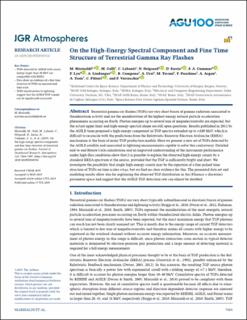| dc.contributor.author | Marisaldi, Martino | |
| dc.contributor.author | Galli, M. | |
| dc.contributor.author | Labanti, C. | |
| dc.contributor.author | Østgaard, Nikolai | |
| dc.contributor.author | Sarria, David | |
| dc.contributor.author | Cummer, S. A. | |
| dc.contributor.author | Lyu, F. | |
| dc.contributor.author | Lindanger, Anders | |
| dc.contributor.author | Campana, R. | |
| dc.contributor.author | Ursi, A. | |
| dc.contributor.author | Tavana, M | |
| dc.contributor.author | Fuschino, F. | |
| dc.contributor.author | Argan, A. | |
| dc.contributor.author | Trois, A. | |
| dc.contributor.author | Pittori, C. | |
| dc.contributor.author | Verrecchia, F | |
| dc.date.accessioned | 2021-01-04T13:00:32Z | |
| dc.date.available | 2021-01-04T13:00:32Z | |
| dc.date.created | 2020-02-25T13:33:34Z | |
| dc.date.issued | 2019 | |
| dc.Published | Marisaldi, M., Galli, M., Labanti, C., Østgaard, N., Sarria, D., Cummer, S. A., et al., On the high-energy spectral component and fine time structure of terrestrial gamma ray flashes. Journal of Geophysical Research: Atmospheres, 2019, 124, 7484–7497 | en_US |
| dc.identifier.issn | 2169-897X | |
| dc.identifier.uri | https://hdl.handle.net/11250/2721284 | |
| dc.description.abstract | Terrestrial gamma ray flashes (TGFs) are very short bursts of gamma radiation associated to thunderstorm activity and are the manifestation of the highest‐energy natural particle acceleration phenomena occurring on Earth. Photon energies up to several tens of megaelectronvolts are expected, but the actual upper limit and high‐energy spectral shape are still open questions. Results published in 2011 by the AGILE team proposed a high‐energy component in TGF spectra extended up to ≈100 MeV, which is difficult to reconcile with the predictions from the Relativistic Runaway Electron Avalanche (RREA) mechanism at the basis of many TGF production models. Here we present a new set of TGFs detected by the AGILE satellite and associated to lightning measurements capable to solve this controversy. Detailed end‐to‐end Monte Carlo simulations and an improved understanding of the instrument performance under high‐flux conditions show that it is possible to explain the observed high‐energy counts by a standard RREA spectrum at the source, provided that the TGF is sufficiently bright and short. We investigate the possibility that single high‐energy counts may be the signature of a fine‐pulsed time structure of TGFs on time scales ≈4 μs, but we find no clear evidence for this. The presented data set and modeling results allow also for explaining the observed TGF distribution in the (Fluence × duration) parameter space and suggest that the AGILE TGF detection rate can almost be doubled. | en_US |
| dc.language.iso | eng | en_US |
| dc.publisher | AGU | en_US |
| dc.rights | Attribution-NonCommercial-NoDerivatives 4.0 Internasjonal | * |
| dc.rights.uri | http://creativecommons.org/licenses/by-nc-nd/4.0/deed.no | * |
| dc.title | On the High‐Energy Spectral Component and Fine Time Structure of Terrestrial Gamma Ray Flashes | en_US |
| dc.type | Journal article | en_US |
| dc.type | Peer reviewed | en_US |
| dc.description.version | publishedVersion | en_US |
| dc.rights.holder | Copyright 2019 The Authors | en_US |
| cristin.ispublished | true | |
| cristin.fulltext | postprint | |
| cristin.qualitycode | 2 | |
| dc.identifier.doi | 10.1029/2019JD030554 | |
| dc.identifier.cristin | 1797353 | |
| dc.source.journal | Journal of Geophysical Research (JGR): Atmospheres | en_US |
| dc.source.40 | 124 | en_US |
| dc.source.14 | 14 | en_US |
| dc.source.pagenumber | 7484-7497 | en_US |
| dc.relation.project | Notur/NorStore: NN9526K | en_US |

